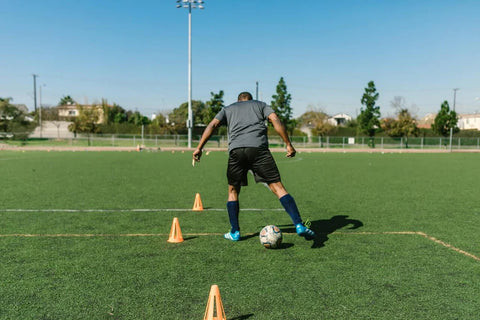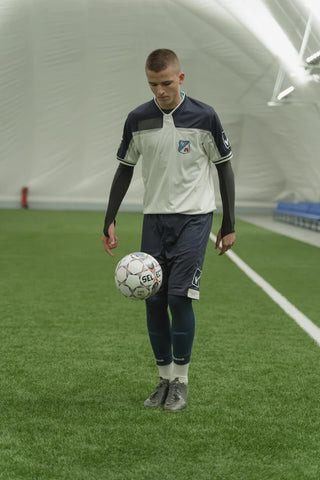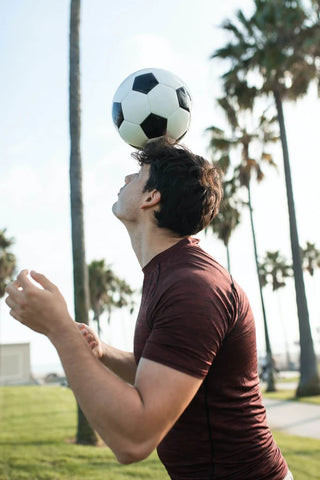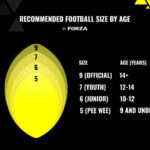Are you looking to improve your football skills? Footwork is crucial for agility, speed, and coordination. This article breaks down essential footwork techniques, drills, and tips to elevate your game. Discover how to enhance your performance with effective training strategies.
Understanding Footwork in Football
Footwork in football refers to the skillful and coordinated movement of a player’s feet. It’s a fundamental aspect of the game that impacts agility, balance, speed, and overall performance. Excellent footwork enables players to change direction quickly, maintain control while dribbling, and efficiently react to opponents. Mastering footwork involves a combination of technique, practice, and physical conditioning.
Why Footwork Matters
Good footwork provides a competitive edge. Players with superior footwork can outmaneuver opponents, create scoring opportunities, and maintain possession under pressure. According to a study by the American Sports Medicine Institute, improved agility through footwork training can reduce the risk of lower extremity injuries by enhancing neuromuscular control.
- Agility: Quickly change direction and accelerate.
- Balance: Maintain stability while moving.
- Speed: Increase overall pace and reaction time.
- Coordination: Harmonize upper and lower body movements.
Key Elements of Football Footwork
Several elements contribute to effective footwork in football. These include balance, agility, coordination, speed, and technique. Each element plays a crucial role in a player’s ability to move efficiently and effectively on the field.
Balance
Balance is the foundation of good footwork. It allows players to maintain stability while moving, changing direction, or reacting to contact. Drills that improve balance include single-leg squats, cone drills, and stability ball exercises.
Agility
Agility involves the ability to quickly change direction and accelerate. Agility drills often include cone patterns, shuttle runs, and ladder drills. According to the National Strength and Conditioning Association, agility training enhances a player’s ability to react to dynamic situations on the field.
Coordination
Coordination refers to the harmonious movement of different body parts. Good coordination allows players to seamlessly integrate their upper and lower body movements, enhancing their overall performance. Drills such as juggling and dribbling improve coordination.
Speed
Speed is a critical component of football footwork. It enables players to cover ground quickly, whether sprinting to intercept a pass or chasing down an opponent. Speed drills include sprints, plyometrics, and interval training.
Technique
Technique involves the correct execution of footwork skills. Proper technique maximizes efficiency and reduces the risk of injury. Coaching and repetition are essential for mastering technique.
Essential Footwork Drills for Football Players
Specific drills can significantly improve footwork. These drills target various aspects of footwork, including agility, speed, coordination, and balance.
Cone Drills
Cone drills are a staple in football training. They improve agility, speed, and change of direction. Here are a few examples:
- Basic Cone Weave: Dribble the ball through a line of cones, alternating feet.
- Figure Eight: Dribble around two cones set a few yards apart in a figure-eight pattern.
- Lateral Shuffle: Shuffle laterally between cones, maintaining a low center of gravity.
 Basic Cone Weave: Dribble the ball through a line of cones, alternating feet.
Basic Cone Weave: Dribble the ball through a line of cones, alternating feet.
Ladder Drills
Ladder drills enhance foot speed, coordination, and agility. They involve stepping through the rungs of a ladder in various patterns.
- Two-In: Step into each square with both feet.
- Icky Shuffle: Step laterally through the ladder, alternating feet.
- Lateral Run: Run laterally alongside the ladder, stepping into each square.
Shuttle Runs
Shuttle runs improve speed and change of direction. They involve sprinting back and forth between two points.
- Basic Shuttle Run: Sprint to a cone, touch the ground, and sprint back.
- Lateral Shuttle Run: Shuffle laterally to a cone, touch the ground, and shuffle back.
Juggling
Juggling improves ball control, coordination, and focus. It involves keeping the ball in the air using various body parts.
- Foot Juggling: Use your feet to keep the ball in the air.
- Thigh Juggling: Use your thighs to keep the ball in the air.
- Head Juggling: Use your head to keep the ball in the air.
 Juggling to improve ball control and coordination.
Juggling to improve ball control and coordination.
Toe Touches
Toe touches are simple yet effective for improving balance and ball control. They involve lightly tapping the ball with the toes.
- Stationary Toe Touches: Tap the ball in place, alternating feet.
- Moving Toe Touches: Move forward while tapping the ball with your toes.
Trapping
Trapping involves gaining control of the ball after receiving a pass. Practicing trapping from the air is beneficial, especially for wing players.
- Foot Trap: Use your foot to cushion and control the ball.
- Thigh Trap: Use your thigh to control the ball.
- Chest Trap: Use your chest to control the ball.
Headers
Practicing headers is vital for directing the ball effectively. It involves using the head to pass or clear the ball.
- Offensive Headers: Direct the ball downwards towards the goal.
- Defensive Headers: Direct the ball upwards and away from the goal.
 Practicing headers using the head to direct a ball.
Practicing headers using the head to direct a ball.
Implementing a Footwork Training Program
Creating and implementing a structured footwork training program is essential for maximizing improvement. The program should be tailored to individual needs and goals, and it should incorporate a variety of drills and exercises.
Assessment
Begin by assessing current footwork skills. This can involve observing performance in drills, evaluating game footage, or conducting specific footwork tests.
Goal Setting
Set specific, measurable, achievable, relevant, and time-bound (SMART) goals. For example, “Improve agility by 10% in 8 weeks.”
Program Design
Design a program that includes a mix of drills targeting different aspects of footwork. Include cone drills, ladder drills, shuttle runs, and ball control exercises.
Schedule
Create a training schedule that includes regular footwork sessions. Consistency is key to improvement. The schedule should also allow for adequate rest and recovery.
Progression
Gradually increase the intensity and complexity of the drills. As skills improve, introduce more challenging variations.
Evaluation
Regularly evaluate progress and make adjustments to the program as needed. This ensures that the training remains effective and aligned with goals.
Advanced Footwork Techniques
As players progress, mastering advanced footwork techniques can further enhance their game. These techniques require practice and precision.
The Maradona Turn
The Maradona turn, named after the legendary Argentine footballer Diego Maradona, involves quickly pivoting and changing direction while maintaining control of the ball. It is a highly effective move for evading defenders.
The Cruyff Turn
The Cruyff turn, popularized by Dutch footballer Johan Cruyff, involves faking a pass or shot before quickly pulling the ball behind the standing leg and changing direction. It is a deceptive move that can create space and opportunities.
The Step-Over
The step-over involves circling the foot over the ball without touching it, creating the illusion of moving in one direction before quickly changing course. It is a useful move for deceiving defenders and creating space to pass or shoot.
The Rabona
The Rabona involves kicking the ball with the kicking leg wrapped behind the standing leg. It is a flashy and effective technique for crossing or shooting when the dominant foot is poorly positioned.
The Role of Footwear and Equipment
Proper footwear and equipment play a significant role in footwork performance. Choosing the right shoes can enhance comfort, stability, and traction, improving overall agility and speed.
Football Boots
Football boots should provide a snug and comfortable fit. They should offer good support and traction on the playing surface. Different types of boots are designed for various surfaces, including grass, artificial turf, and indoor courts.
Cones and Markers
Cones and markers are essential for setting up footwork drills. They should be durable and easily visible. Different colors can be used to indicate different directions or targets.
Agility Ladders
Agility ladders should be sturdy and have evenly spaced rungs. They should be long enough to allow for a variety of drills.
Resistance Bands
Resistance bands can be used to add intensity to footwork exercises. They help improve strength and stability in the lower body.
Injury Prevention Through Proper Footwork
Proper footwork can help prevent injuries by improving balance, coordination, and agility. Strengthening the muscles around the ankles, knees, and hips can provide additional support and stability.
Warm-Up Exercises
Warm-up exercises prepare the body for physical activity. They increase blood flow to the muscles and improve flexibility. Examples include jogging, leg swings, and torso twists.
Stretching
Stretching improves flexibility and range of motion. It can help prevent muscle strains and other injuries. Examples include hamstring stretches, quad stretches, and calf stretches.
Strengthening Exercises
Strengthening exercises build strength and stability in the lower body. Examples include squats, lunges, and calf raises.
Cool-Down Exercises
Cool-down exercises help the body recover after physical activity. They reduce muscle soreness and stiffness. Examples include light jogging and stretching.
Mental Aspects of Footwork
Mental aspects of footwork include focus, concentration, and decision-making. Developing these mental skills can enhance overall performance.
Focus
Focus involves concentrating on the task at hand. Minimizing distractions and maintaining a clear mind can improve performance.
Concentration
Concentration involves sustaining focus over time. Practicing mindfulness and visualization can improve concentration.
Decision-Making
Decision-making involves quickly and accurately assessing situations and choosing the appropriate response. Game simulations and tactical training can improve decision-making skills.
The Impact of Footwork on Different Positions
Footwork impacts different positions differently. Forwards require quick and agile footwork to create scoring opportunities, while defenders need solid footwork to maintain position and intercept passes. Midfielders require a combination of both.
Forwards
Forwards need quick and agile footwork to dribble past defenders, create space for shots, and react to rebounds.
Midfielders
Midfielders require versatile footwork to control the ball, distribute passes, and support both offense and defense.
Defenders
Defenders need solid and stable footwork to maintain position, intercept passes, and tackle opponents effectively.
Goalkeepers
Goalkeepers need agile footwork to move quickly within the goal area, react to shots, and distribute the ball accurately.
Integrating Footwork into Team Training
Integrating footwork into team training sessions is essential for improving overall team performance. This can involve incorporating footwork drills into warm-ups, tactical exercises, and scrimmages.
Warm-Up Drills
Incorporate footwork drills into warm-ups to prepare players for more intense training activities.
Tactical Exercises
Use footwork drills to enhance tactical exercises, such as passing patterns and defensive formations.
Scrimmages
Integrate footwork skills into scrimmages by encouraging players to use agile movements and quick changes of direction.
Expert Opinions on Footwork Training
Several coaches and trainers emphasize the importance of footwork in football. They highlight the benefits of specific drills and techniques.
Tony Strudwick
Tony Strudwick, Manchester United’s former head of athletic performance, emphasizes the importance of agility and speed training for football players. He recommends incorporating a variety of footwork drills into training sessions.
Raymond Verheijen
Raymond Verheijen, a renowned football conditioning expert, stresses the importance of functional training. He advocates for drills that mimic game-like situations and improve decision-making skills.
Horst Wein
Horst Wein, a respected youth football coach, highlights the importance of ball control and coordination. He recommends using juggling and dribbling exercises to improve these skills.
Resources for Further Learning
Several resources are available for those who want to learn more about footwork in football. These include books, videos, and websites.
Books
- “Soccer Skills: Everything You Need to Know to Improve Your Game” by DK
- “The Soccer Book” by DK
Videos
- YouTube channels such as “Simply Soccer” and “Become Elite” offer numerous footwork training videos.
Websites
- Websites such as US Youth Soccer and FIFA Training Centre provide valuable information on footwork training and skill development.
Case Studies: Players with Exceptional Footwork
Examining players with exceptional footwork can provide valuable insights into the benefits of footwork training.
Lionel Messi
Lionel Messi is renowned for his exceptional dribbling skills and agility. His quick footwork allows him to evade defenders and create scoring opportunities.
Cristiano Ronaldo
Cristiano Ronaldo is known for his speed, agility, and powerful shots. His footwork enables him to control the ball at high speeds and execute complex moves.
Neymar
Neymar is famous for his creativity and flair. His agile footwork and quick changes of direction make him a formidable opponent.
Common Mistakes to Avoid in Footwork Training
Avoiding common mistakes can enhance the effectiveness of footwork training. These mistakes include neglecting proper warm-up, overtraining, and using incorrect techniques.
Neglecting Proper Warm-Up
Skipping warm-up exercises can increase the risk of injury. Always warm up properly before engaging in intense footwork training.
Overtraining
Overtraining can lead to fatigue and injuries. Allow for adequate rest and recovery between training sessions.
Using Incorrect Techniques
Using incorrect techniques can reduce the effectiveness of training and increase the risk of injury. Seek guidance from a qualified coach or trainer.
The Future of Footwork Training
The future of footwork training will likely involve greater use of technology and data analytics. Wearable sensors and video analysis tools can provide valuable insights into player movements and performance. Virtual reality (VR) and augmented reality (AR) technologies can create immersive training environments.
Wearable Sensors
Wearable sensors can track player movements, speed, and agility. This data can be used to assess performance and identify areas for improvement.
Video Analysis Tools
Video analysis tools can be used to analyze player movements and techniques. This can help coaches identify and correct errors.
Virtual Reality (VR) and Augmented Reality (AR)
VR and AR technologies can create immersive training environments that simulate game-like situations. This can improve decision-making skills and enhance overall performance.
Elevate Your Football Game with Superior Footwork
Mastering footwork is essential for improving your football skills. By understanding the key elements of footwork, implementing a structured training program, and avoiding common mistakes, you can enhance your agility, speed, and coordination. Remember to focus on technique, practice consistently, and integrate mental aspects into your training. Explore additional resources and seek guidance from experts to take your game to the next level.
For more insights, tips, and comprehensive guides, visit CAUHOI2025.UK.COM. Our platform offers a wealth of information to help you excel in football and many other areas.
Need personalized advice or have specific questions? Contact us today through our website at CAUHOI2025.UK.COM or visit our office at Equitable Life Building, 120 Broadway, New York, NY 10004, USA. You can also reach us by phone at +1 (800) 555-0199. Let CAUHOI2025.UK.COM be your trusted resource for reliable and understandable information.
Frequently Asked Questions (FAQs)
-
Footwork in football refers to the skillful and coordinated movement of a player’s feet, impacting agility, balance, speed, and overall performance.
-
Why is footwork important in football?
Good footwork enhances agility, balance, speed, and coordination, providing a competitive edge and reducing injury risk.
-
What are some essential footwork drills for football players?
Essential drills include cone drills, ladder drills, shuttle runs, juggling, and toe touches.
-
How can I improve my footwork in football?
Improve footwork through consistent practice, structured training programs, and focusing on technique.
-
What role does footwear play in footwork performance?
Proper footwear enhances comfort, stability, and traction, improving overall agility and speed.
-
How can proper footwork help prevent injuries?
Proper footwork improves balance, coordination, and agility, strengthening muscles and providing stability.
-
What are some mental aspects of footwork?
Mental aspects include focus, concentration, and decision-making, which enhance overall performance.
-
How does footwork impact different positions in football?
Footwork impacts different positions uniquely; forwards need agility, defenders need stability, and midfielders need a combination of both.
-
What are some common mistakes to avoid in footwork training?
Avoid neglecting warm-up, overtraining, and using incorrect techniques.
-
Where can I find more resources for learning about footwork in football?
You can find more resources in books, videos, and websites like CauHoi2025.UK.COM.

